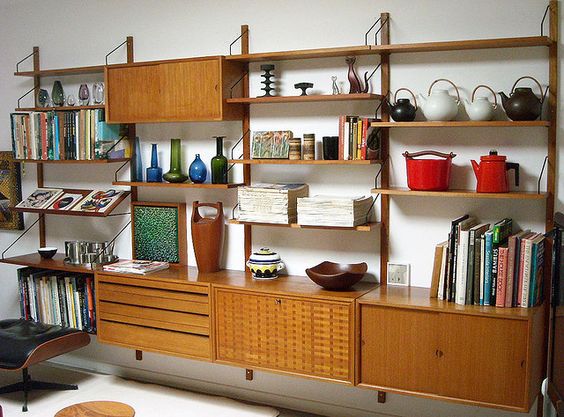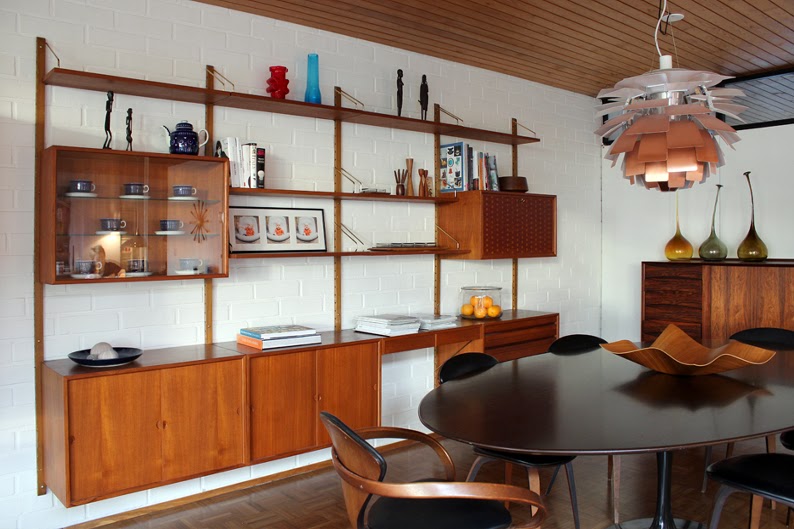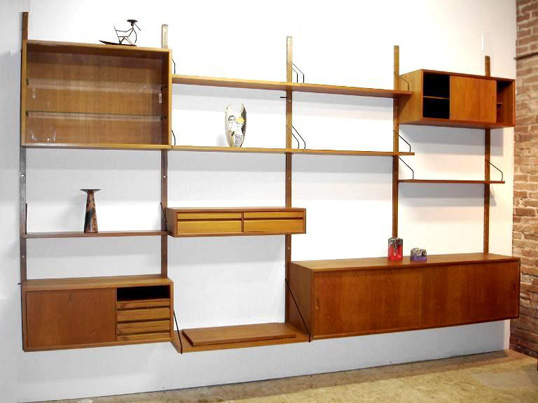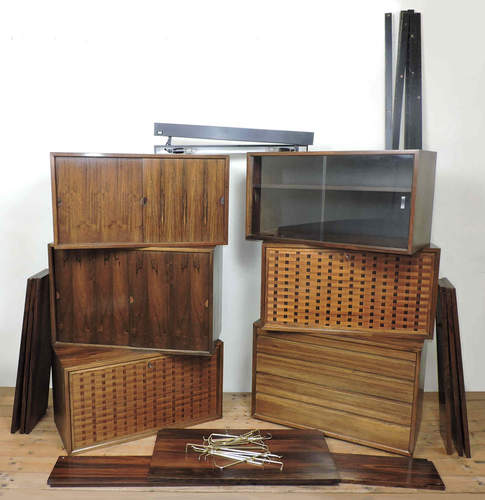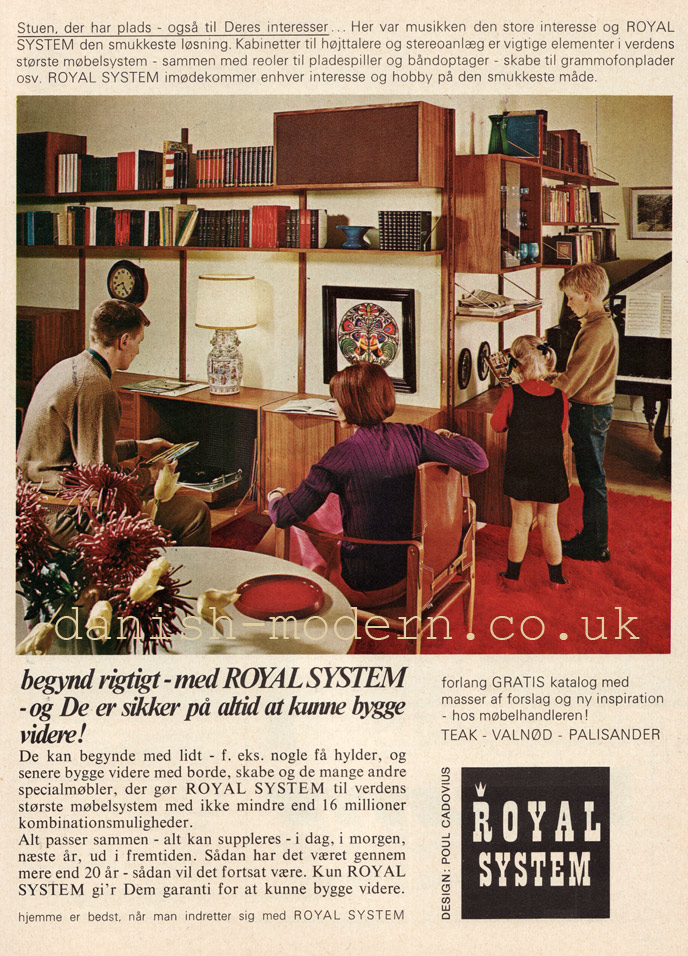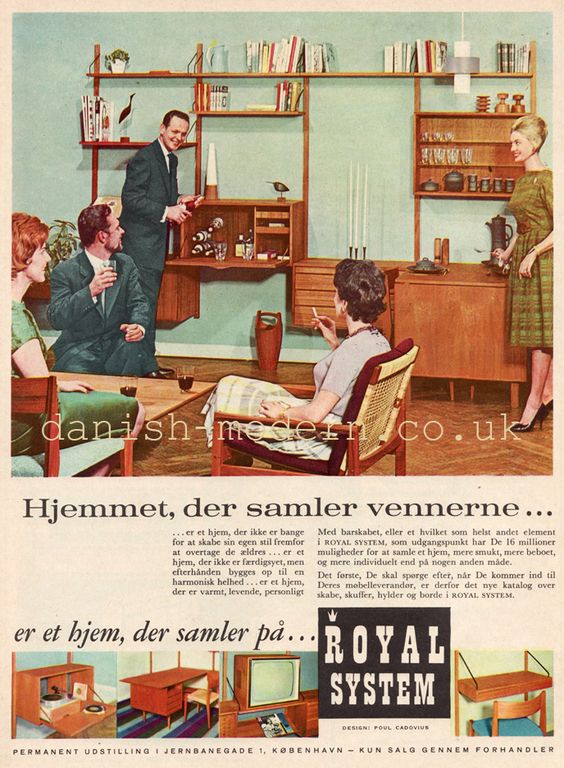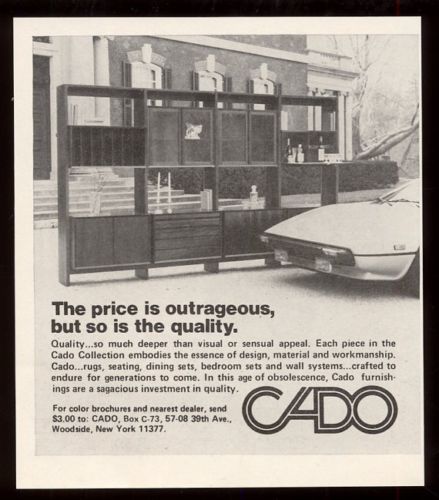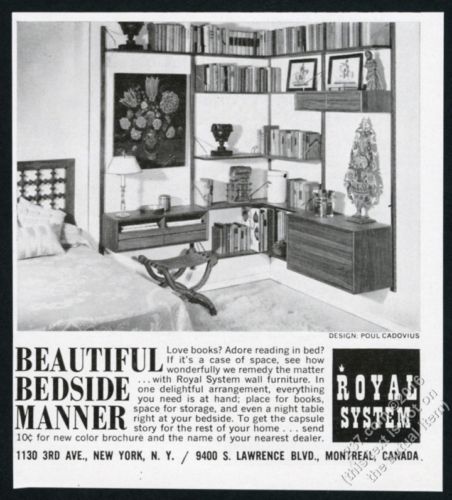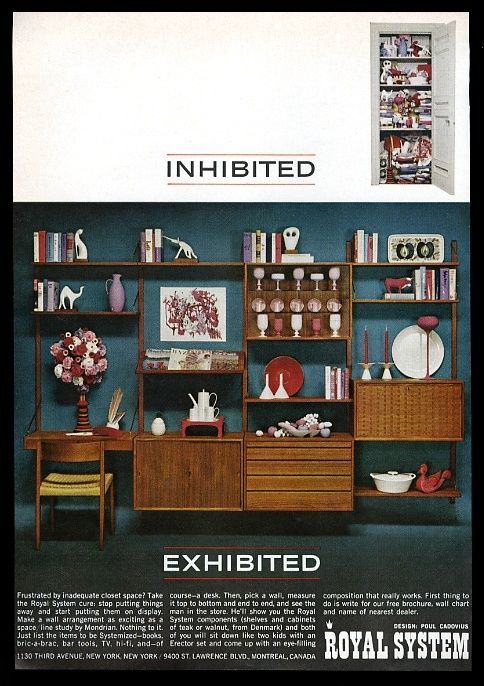SOLD. Danish Teak Poul Cadovious Royal System
SOLD.
ROYAL SYSTEM®
Design by Poul Cadovius, 1948
Back in 1948 furniture designer Poul Cadovius created the world’s first wall-mounted shelving system ROYAL SYSTEM®, which also was a breakthrough because of its light styling and the many individual combination possibilities. The furniture system therefore became a worldwide succes.
The ROYAL SYSTEM® has today been lifted into the modern age. In its modern appearance ROYAL SYSTEM® is suitable for both residential and commercial interior design.
The ROYAL SYSTEM configurator – here you can combine your own shelving system!
Dimensions (Width x Depth x Height in inches): comes with one authentic key to lock all cabinets
5 x Wooden wall rails 1.5 x 2 x 105 cm / adjustable height
1 x Desktop shelf / work station (laptop) with drawer 31.5 x 17.75 x 5.5 inches
3 x Cabinets w/pulldown doors 31.5 x 16.75 x 15 inches / all can be locked / front panels in woven rosewood
– one is a vintage records holder, with centre divider
– one is fully open in the interior
– one is a “bar” with wine holder (6 horizontal bottles) and room for upright alcohol/wine bottle also.
2 x Cabinet w/2 wooden sliding doors:
– one is 31.5 x 17 x 15 inches
– one is 31.5 x 17 x 7.25 inches
* includes all authentic hardware / hangers.
Material:
walnut & rosewood
Hangers:
Raw brass
Surface treatment:
Oil, matt lacquer or soap
Shelves will flex slightly over time but will still retain their structural integrity.
We recommend a weight limit of 35 pounds/15 kg per shelf to maintain a straight profile.
Fine, mid-century, Danish Teak design at it’s most versatile. Described back in a sixties advertisement as “The beautiful solution for your space problems”.
Condition: Once the 5 wall bearers are attached to the wall, the cabinets and shelves can easily be moved around to create many different combinations.This example in rosewood, with many components. As the system stands and presents, there is a general overall level of honest and expected distressing. A fine quality, well aged system which functions as it should.
More info & images on request.
Designer: Poul Cadovius
Producer: Cado
Designer’s country: Denmark
Function: Shelving & storage
Period: 1960 – 1969
MORE:
Great Danish Designers 101:
Poul Cadovius
06 January, 2016
In our blog series on Danish designers of the mid-century period, we’ve talked a lot about the overall Scandinavian design ethos that influenced them: human-centred design, traditional craft and carpentry skills, and the use of organic forms. Efficiency is another important element of that design ethos and one that greatly inspired Poul Cadovius, inventor of the renowned—and still very popular—Royal shelving system.
A Tradition of Efficiency
Nordic architects and furniture designers have a long history of creating efficiency in built spaces. Even before the mid-century period, houses were designed to minimize or eliminate wasted space. Furniture designers followed the same principle by creating modular furniture that could adapt to different uses and save precious space. The end result was “an acute spatial awareness among generations of Scandinavians, and an appreciation of the interior as a flexible entity rather than a static fixture.” (Scandinavian Style)
Translated to the real world, this focus on efficiency led to: built-in cupboards that were fully functional but integrated unobtrusively into a room, in alcoves, and under stairs; beds that tucked away, upright, into cupboards; use of the entire height of a room, with cupboards and wardrobes stretching from floor to ceiling;
modular seating that allowed different configurations, and tables that extended when more surface space was needed.
Shelving was another area where efficiency and flexibility came to the fore. Bradley Quinn wrote about the way shelving was transformed by Scandinavian designers:
“Shelving moved beyond the confines of the bookcase, and was reinvented as a flexible, modular system featuring sleek display surfaces in addition to storage spaces.”
Modular shelving units can accommodate desks, closed cabinets, and open shelves. According to Quinn, this flexibility allows everyday personal items to be kept close at hand, but behind closed doors, while also providing “lustrous display surfaces” for decorative objects.
Poul Cadovius recognized the need for this kind of flexible storage system in the 1940s. By the end of that decade he had created an original wall-hung shelving system that would become one of the Danish furniture industry’s biggest success stories.
Poul Cadovius: King of Modular Shelving
Poul Cadovius was born in 1911 in Frederiksberg, Denmark. Trained originally as a saddler and upholsterer, he later moved into furniture design.
Although recognized as a very influential designer, there is surprisingly little written about Cadovius. From the few sources that do exist, we can glean that his design impulses were very much influenced by his Danish upbringing. Like other designers of the period, he was interested in creating furniture that would provide comfort and make the living space larger. He also sought to make highly customizable pieces that were flexible enough to suit any décor and be arranged in a manner that underlined the “personal atmosphere of the interior.” (http://bit.ly/1MT8xt8)
Cadovius later purchased the furniture manufacturer France & Sons, which he renamed Cado. He continued producing his shelving system, which sometimes goes by the name Cado, but also designed other furniture. In fact, according to Nest.co.uk, Cadovius registered more than 400 patents in his lifetime. In his later designs, he followed the Danish tradition of using tropical woods like teak and rosewood, but also experimented with other materials.
As his number of patents suggests, Cadovius was always innovating. He even modified his most successful design, creating a version of the Royal System that was freestanding rather than wall-mounted.
Royal shelving systems may have been designed nearly 70 years ago, but they are “hot collectibles” today. With our urban centres increasingly focused on efficient use of land and smaller living spaces, modular designs are essential. Like other designs from the mid-century period, those of Poul Cadovius have stood the test of time, and may be even more relevant now than they were then.

